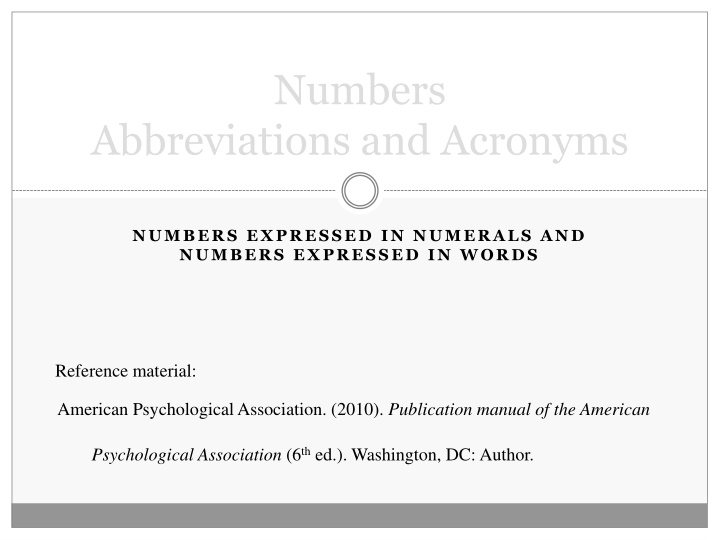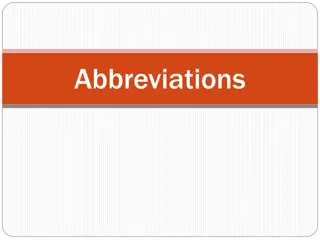Guidelines for Using Numbers, Abbreviations, and Acronyms in Academic Writing
Learn the proper usage of numbers, whether to express them in numerals or words depending on the context. Understand when to use abbreviations like initialisms and acronyms, and how to introduce and utilize them effectively in scholarly papers. Follow the guidelines outlined by the American Psychological Association for clarity and consistency in academic writing.
Download Presentation

Please find below an Image/Link to download the presentation.
The content on the website is provided AS IS for your information and personal use only. It may not be sold, licensed, or shared on other websites without obtaining consent from the author.If you encounter any issues during the download, it is possible that the publisher has removed the file from their server.
You are allowed to download the files provided on this website for personal or commercial use, subject to the condition that they are used lawfully. All files are the property of their respective owners.
The content on the website is provided AS IS for your information and personal use only. It may not be sold, licensed, or shared on other websites without obtaining consent from the author.
E N D
Presentation Transcript
Numbers Abbreviations and Acronyms NUMBERS EXPRESSED IN NUMERALS AND NUMBERS EXPRESSED IN WORDS Reference material: American Psychological Association. (2010). Publication manual of the American Psychological Association (6th ed.). Washington, DC: Author.
Use Words for: Numbers less than 10 five participants two experiments Common fractions one third of the members of the first group a two-thirds majority Numbers that start a sentence Three different conditions were tested. Fifty college students participated in the study. Universally accepted usage The Twelve Apostles Five Pillars of Islam
Use Numerals for: Numbers 10 and above 65 items 10 points The 13th participant Numbers in the abstract of the paper (except to start a sentence) Numbers preceding a unit of measurement or time 5 cm 12 lbs 3 min 6 weeks
Numerals (continued) Numbers that are used as fractions (except common fractions), decimals, percentages, ratios, and percentiles 3/16 75% of the population A ratio of 10:1 The 95th percentile
Numerals (continued) Numbers that represent time, date, age, scores and points on a scale Lunch is at 12:30 p.m. 2-year-olds A score of 5 on a 10-point scale A 5-point scale ranging from 1 (not at all) to 5 (extremely) June 13th Numbers that represent a specific place in a series Condition 1, Condition 2, Condition 3, etc. Group 5, Group 6, Group 7, etc. Participant 12, Participant 13, Participant 14, etc.
Abbreviations Abbreviations that are pronounced one letter at a time (e.g., APA, DSM, BDI, IQ) are called initialisms Abbreviations that are pronounced as a word are called acronyms (e.g., AIDS) Abbreviations should be used sparingly. Use them when: 1. The abbreviation is standard and it will not interrupt the reader s understanding (e.g., AIDS) 2. If space can be saved and repetition can be avoided with the use of the abbreviation
Use of Initialisms & Acronyms Use the full term the first time, followed immediately by the initialism or acronym in parentheses (include any necessary citation within the same parentheses, separated by a semi-colon) Human immunodeficiency virus (HIV) Beck Depression Inventory (BDI; Beck, Ward, Mendelsohn, Mock, & Erbaugh, 1961) Do not use the full term in your paper after this point.
Examples My first group of participants would exercise in a peppermint-scented room, after which they would complete the State form of the State-Trait Anxiety Inventory (STAI; Spielberger, Gorsuch, & Lushene, 1970). According to the American Psychological Association (APA), abbreviations can help shorten a paper; however, the APA suggests avoiding abbreviations that may confuse your reader.
Common Abbreviations Latin abbreviations: cf. e.g., i.e., viz., vs. etc. Units of time: s min hr ms ns Units of measurement: a.m. C cm F g Hz in. kg L m ml mm p.m. V W Do not add an s after any abbreviation of a unit of measurement
Examples I like many fruits (e.g., strawberries, grapes, cantaloupe). She defected from the relationship (i.e., she left him). The participants had 5 hr to complete the task. Each mouse in Group 2 received 3 g of the experimental drug.























